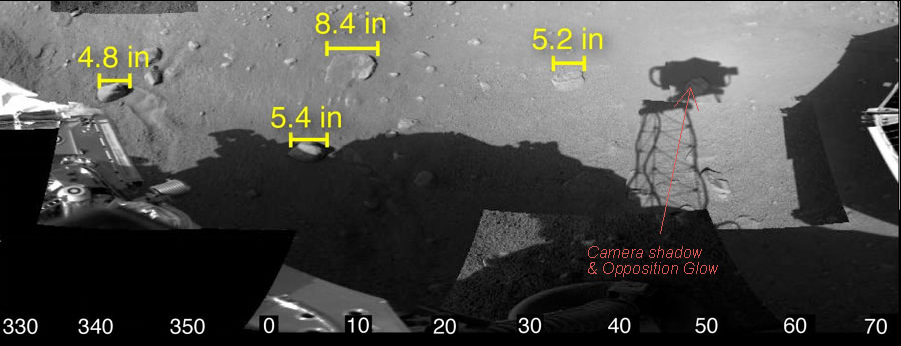Mars Opposition Glow
Mars Opposition Glow: Exploring the Phenomenon
When it comes to studying the celestial bodies in our solar system, Mars holds a special place. Among the many intriguing phenomena observed on Mars is the "Opposition Effect Glow." This captivating effect can be seen in images captured by the Phoenix Mars Lander, showcasing not only nearby rock sizes but also the unique glow around the camera shadow.
The camera shadow, marked by a red arrow, indicates the antisolar point directly opposite the sun. Interestingly, the area surrounding the camera shadow appears noticeably brighter. This brightness is attributed to several factors that contribute to the opposition effect glow on Mars.
One key factor is the behavior of rock shadows in relation to the antisolar point. As we observe the rocks in the image, we notice that their shadows all point towards the antisolar point. As we move closer to this point, the shadows become shorter and are often hidden from the camera by the rocks themselves. This results in a brighter appearance in that specific area.
Additionally, minerals present in the rocks on Mars might exhibit retro-reflection, which further enhances the opposition glow effect. Retro-reflection occurs when light is reflected back in the direction it came from, creating a concentrated and intensified glow. This phenomenon adds to the overall brightness observed during opposition.
Another contributing factor to the opposition effect glow on Mars is coherent backscattering. Coherent backscattering refers to the scattering of light in a specific direction due to interference effects. This scattering causes an increase in brightness when observing an object from the antisolar point. The combined influence of retro-reflection and coherent backscattering contributes to the mesmerizing glow seen in opposition images of Mars.
It is important to note that this phenomenon is distinct from the Heiligenschein, which is produced by water drops. The opposition effect glow on Mars arises from different mechanisms and characteristics unique to its environment.
Interestingly, this opposition effect is not exclusive to Mars. Similar phenomena can also be observed on the moon and asteroids, indicating that these celestial bodies share common optical properties that contribute to the opposition glow.
In conclusion, the opposition effect glow on Mars is a fascinating phenomenon that adds to the allure of this neighboring planet. The interplay of factors such as rock shadows, retro-reflection, and coherent backscattering results in a distinctive brightness observed during opposition. Understanding these optical phenomena allows us to delve deeper into the mysteries of our solar system and appreciate the wonders of celestial optics.

Opposition Effect Glow on Mars
This panorama of Phoenix Mars Lander images was made to show nearby rock sizes. It shows something else - an opposition effect glow.
The area around the camera shadow (red arrowed) is noticeably brighter. The camera shadow marks the antisolar point directly opposite the sun. Notice how the rock shadows all point there. Close to the point the shadows are very short and are hidden from the camera by the rocks themselves - the area thus looks brighter. Minerals in the rocks might also retro-reflect and a further effect called coherent backscattering contributes to opposition glows. One thing we can be sure of, there is no Heiligenschein produced by water drops!
Mars is brighter in our skies at opposition for these reasons, and hence the name. We see a similar effect on the moon and asteroids.
Note: this article has been automatically converted from the old site and may not appear as intended. You can find the original article here.
Reference Atmospheric Optics
If you use any of the definitions, information, or data presented on Atmospheric Optics, please copy the link or reference below to properly credit us as the reference source. Thank you!
-
<a href="https://atoptics.co.uk/blog/mars-opposition-glow/">Mars Opposition Glow</a>
-
"Mars Opposition Glow". Atmospheric Optics. Accessed on November 26, 2024. https://atoptics.co.uk/blog/mars-opposition-glow/.
-
"Mars Opposition Glow". Atmospheric Optics, https://atoptics.co.uk/blog/mars-opposition-glow/. Accessed 26 November, 2024
-
Mars Opposition Glow. Atmospheric Optics. Retrieved from https://atoptics.co.uk/blog/mars-opposition-glow/.